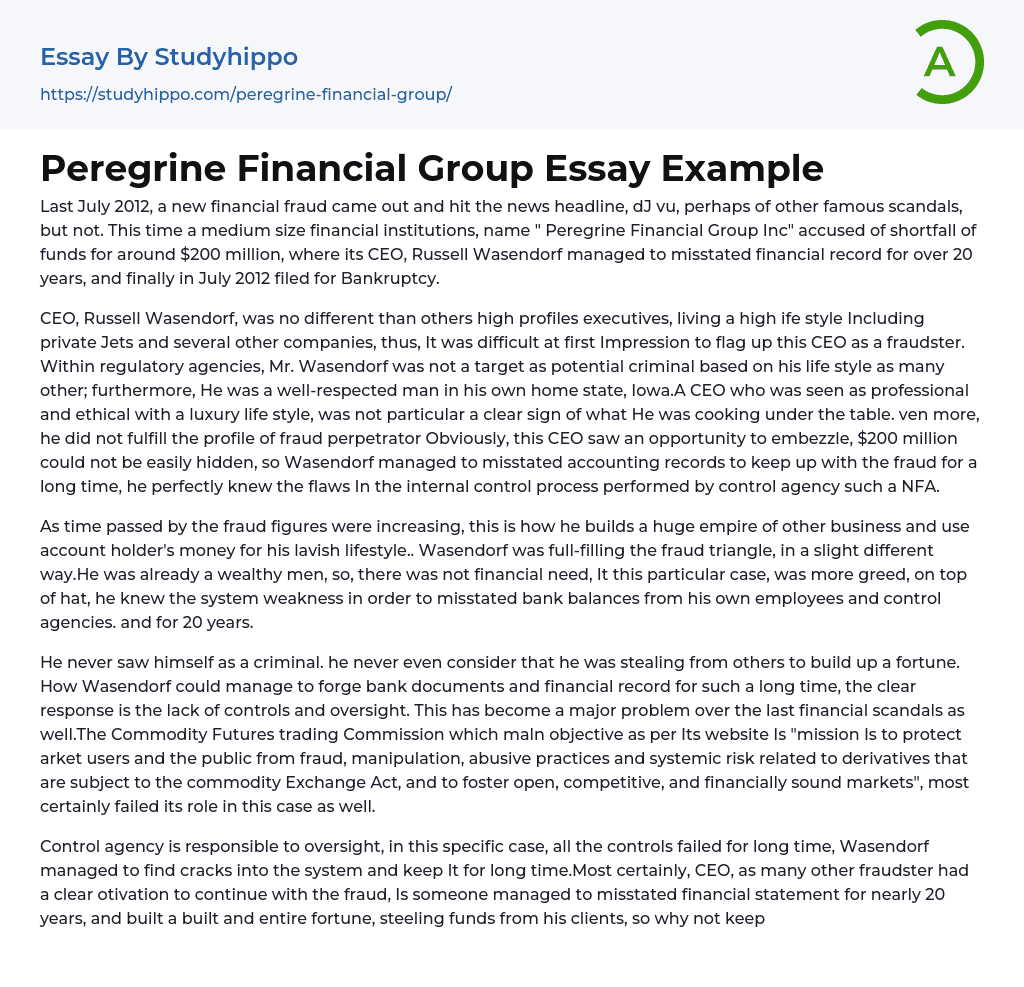In July 2012, a financial fraud made headlines, reminiscent of previous scandals but unique in its own right. A medium-sized financial institution called "Peregrine Financial Group Inc" was accused of a shortfall of funds of approximately $200 million. Russell Wasendorf, the CEO, had been misstating financial records for over 20 years. In July 2012, the company filed for bankruptcy.
Despite living a lavish lifestyle that included private jets and owning several other companies, CEO Russell Wasendorf did not initially appear to be a fraudster. His reputation in Iowa as a professional and ethical man further added to this perception. Regulatory agencies did not view him as a potential criminal based on his lifestyle, unlike many others. However, Wasendorf saw an opportunity to embezzle and managed to hide $200 million by misstating accounting records. He was able to mai
...ntain the fraud for an extended period of time due to flaws in the internal control process implemented by control agencies such as NFA.
Over a period of 20 years, Wasendorf grew a vast business empire by misusing the money of account holders for his extravagant lifestyle. Although he was already wealthy and did not have a financial need, he succumbed to greed. Wasendorf exploited weaknesses in the system to misrepresent his company's bank balances to his employees and regulatory authorities. This fulfilled the fraud triangle, albeit in a slightly different manner.
The fact that Wasendorf was able to forge bank documents and financial records without realizing he was committing a crime highlights the lack of oversight and controls in place. This issue has also been prevalent in recent financial scandals. The Commodity Futures Trading Commission, whose main objectiv
is to protect the public and market users from fraud, manipulation, abusive practices, and systemic risk related to derivatives subject to the Commodity Exchange Act, failed in their responsibility in this case.
The control agency, responsible for oversight, failed to prevent long-term fraudulent activities by Wasendorf who exploited weaknesses in the system. Despite clear motivation to continue the fraud, the CEO managed to misstate financial statements for almost two decades, resulting in stolen funds from clients. NFA auditors overlooked a critical event during their audit of FTG books as they received erroneous balance confirmation information from PFG's US bank. Despite the fraud being highlighted, auditors did not follow up, and this has again raised questions about the effectiveness of control agencies. Although lessons are learned after major fraud scandals occur and controls and laws increase, fraudulent activities continue. While the CEO has been sentenced to 50 years in prison and fined heavily, third-party harm remains unresolved, and $200 million is still missing.Although similar lessons have been learned from previous large-scale fraud cases, this type of fraudulent activity continues to persist. Criticisms have been directed towards the inadequate controls in place and the non-proactive role of control agencies.
It is evident that a change is necessary. Although there are more controls and laws in place, fraud continues to occur even though there is a common practice of publishing lesson learnt papers after large fraud scandals. This particular case is one of many instances of White Collar crime, the majority of which do not receive media coverage.
It is the responsibility of society to track and prosecute all forms of fraud in order to guarantee appropriate punishment for white-collar criminals.
- Money essays
- Financial Accounting essays
- Market Segmentation essays
- Supply And Demand essays
- Purchasing essays
- Forecasting essays
- Legacy essays
- Bank essays
- Corporate Finance essays
- Financial News essays
- Financial Ratios essays
- Financial Services essays
- Free Market essays
- Shareholder essays
- Personal finance essays
- Equity essays
- Financial Crisis essays
- Banking essays
- Credit Card essays
- Currency essays
- Debt essays
- Gold essays
- Loan essays
- Enron Scandal essays
- Foreign Exchange Market essays
- Investment essays
- Venture Capital essays
- Stock Market essays
- Retirement essays
- Donation essays
- Net Present Value essays
- Income Statement essays
- Commercial Bank essays
- Debit Card essays
- Deposit Account essays
- Subprime Lending essays
- Perfect Competition essays
- Underwriting essays
- Synergy essays
- Valuation essays
- Investing essays
- Asset essays
- Depreciation essays
- Discounted Cash Flow essays
- Foreign Direct Investment essays
- Funds essays
- Internal Rate Of Return essays
- Revenue essays
- Day Trading essays
- Futures Trading essays




